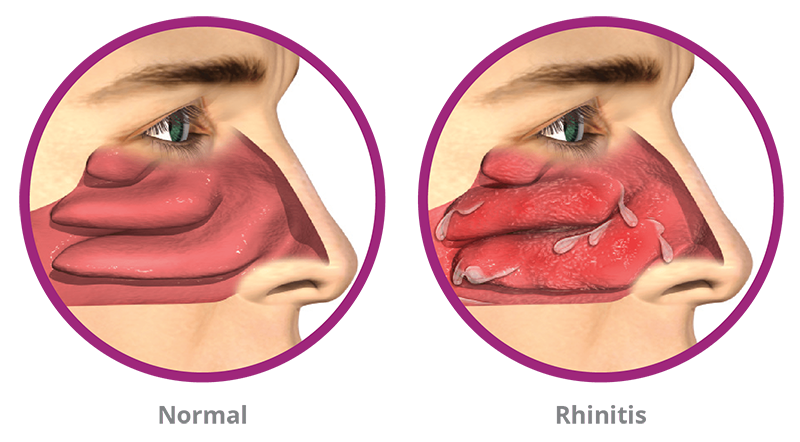Chronic non-allergic rhinitis (CNAR) is a prevalent condition that impacts the nasal passages, leading to persistent symptoms without the involvement of allergens. Unlike allergic rhinitis, which triggers an immune response to substances like pollen or dust, chronic non-allergic rhinitis is characterized by inflammation of the nasal lining, causing discomfort and congestion. This article delves into the symptoms, causes, and treatment strategies for chronic non-allergic rhinitis, offering a thorough understanding of this condition and how to manage it.

What is Chronic Non-Allergic Rhinitis?
Chronic non-allergic rhinitis refers to the inflammation of the nasal mucosa that persists for more than 12 weeks. This condition manifests similarly to allergic rhinitis, but without any identifiable allergens involved. Patients with CNAR experience persistent nasal congestion, runny nose, post-nasal drip, and sneezing. The exact cause of the inflammation often remains unclear, but various environmental, lifestyle, and physiological factors can contribute to its development.
Symptoms of Chronic Non-Allergic Rhinitis
Chronic non-allergic rhinitis presents a range of symptoms that can disrupt daily life and impact overall health. These symptoms may include:
- Nasal Congestion: A persistent feeling of a blocked nose, making it difficult to breathe freely.
- Runny Nose: Continuous or intermittent nasal discharge, often clear or watery.
- Post-Nasal Drip: Mucus draining from the nasal passages down the back of the throat, which may lead to coughing or throat irritation.
- Sneezing: Frequent sneezing, often triggered by changes in temperature or humidity.
- Nasal Itchiness: Mild to moderate discomfort in the nasal passages.
Unlike allergic rhinitis, chronic non-allergic rhinitis does not include symptoms like itchy eyes or skin reactions, which are common in allergic rhinitis.
Causes of Chronic Non-Allergic Rhinitis
The exact cause of chronic non-allergic rhinitis remains elusive, but several factors have been identified that may contribute to the development of this condition:
1. Environmental Factors
- Air Pollution: Exposure to pollutants like cigarette smoke, vehicle exhaust, and industrial emissions can irritate the nasal passages.
- Dry or Cold Air: Extreme weather conditions, especially cold or dry air, can exacerbate symptoms.
- Strong Odors: Exposure to perfumes, cleaning products, or chemicals can trigger nasal symptoms.
2. Hormonal Changes
Hormonal fluctuations, especially during pregnancy or in individuals taking oral contraceptives, can contribute to nasal congestion and inflammation.
3. Medications
Some medications, particularly nasal decongestant sprays, can lead to rebound congestion if used excessively, which can be a trigger for chronic non-allergic rhinitis.
4. Structural Abnormalities
Issues such as a deviated septum or nasal polyps can interfere with normal nasal airflow, promoting inflammation and congestion.
5. Infections
Viral upper respiratory infections can irritate the nasal passages, and in some cases, these infections may cause long-term symptoms similar to rhinitis.
6. Diet and Lifestyle Factors
Spicy foods, alcohol, and stress may exacerbate nasal symptoms in some individuals.
Diagnosis of Chronic Non-Allergic Rhinitis
A thorough diagnosis of chronic non-allergic rhinitis typically involves a clinical examination by an ENT (ear, nose, and throat) specialist. The process may include:
- Medical History: A detailed review of symptoms, triggers, and any past treatments.
- Physical Examination: Examination of the nasal passages to rule out structural abnormalities such as nasal polyps or a deviated septum.
- Allergy Testing: To confirm that the symptoms are not related to allergens.
- Endoscopy: In some cases, a nasal endoscopy may be conducted to examine the nasal cavities in more detail.
Treatment Options for Chronic Non-Allergic Rhinitis
Managing chronic non-allergic rhinitis requires a multi-faceted approach that targets both symptom relief and the underlying causes. The following treatment strategies are commonly recommended:
1. Nasal Steroid Sprays
Nasal corticosteroids are the most effective treatment for chronic non-allergic rhinitis. These sprays reduce inflammation in the nasal passages and help alleviate congestion and other symptoms. Examples include fluticasone and mometasone.
2. Antihistamines
Although antihistamines are typically used for allergic rhinitis, they can also be effective in treating some symptoms of CNAR, particularly sneezing and runny nose. Non-sedating options such as loratadine or cetirizine are often preferred.
3. Saline Nasal Irrigation
Rinsing the nasal passages with a saline solution can help clear mucus and allergens from the nose, providing relief from congestion.
4. Decongestants
Oral or nasal decongestants such as pseudoephedrine or oxymetazoline can temporarily relieve nasal congestion. However, nasal decongestant sprays should not be used for more than three consecutive days to avoid rebound congestion.
5. Lifestyle Modifications
- Humidification: Using a humidifier to maintain optimal humidity levels in the home can prevent dryness and irritation of the nasal passages.
- Avoidance of Triggers: Identifying and avoiding environmental triggers such as smoke, strong odors, or pollution can reduce symptom flare-ups.
6. Immunotherapy
While immunotherapy is typically reserved for allergic rhinitis, some studies suggest it may benefit individuals with non-allergic rhinitis who have a hypersensitivity to environmental irritants.
Preventing Chronic Non-Allergic Rhinitis Symptoms
While chronic non-allergic rhinitis may not be entirely preventable, there are several steps individuals can take to minimize the impact of the condition:
- Avoid Environmental Triggers: Limiting exposure to pollutants, chemicals, and strong odors is crucial for individuals with CNAR.
- Use Nasal Sprays as Directed: Following the prescribed dosage and frequency for nasal steroid sprays can prevent symptom exacerbation.
- Manage Stress: Stress is a known trigger for many chronic conditions, including rhinitis. Practicing relaxation techniques such as yoga or meditation may help manage symptoms.
- Maintain Nasal Health: Regular use of saline nasal sprays and maintaining adequate humidity levels can help keep nasal passages moist and healthy.
When to See a Doctor
If symptoms of chronic non-allergic rhinitis persist for more than 12 weeks or worsen despite home treatments, it is advisable to consult an ENT specialist. A healthcare professional can rule out other conditions such as sinusitis, nasal polyps, or structural issues that may require surgical intervention.